Thuja care in the fall: the main activities for preparing the ephedra for winter
Despite the fact that thuja is a rather unpretentious evergreen coniferous plant, it, like many other perennials, needs to be provided with some preparation for winter.
Let's talk about this (autumn care and preparation for a successful wintering) in detail.
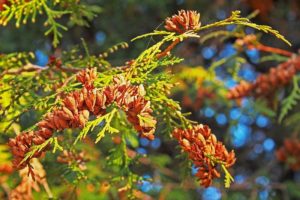
Content
- 1 Features of thuja care in the fall and preparation for winter - general tips and tricks
- 2 Watering and autumn feeding of thuja
- 3 Pruning thuja in autumn
- 4 Treatment against diseases and pests
- 5 What to do if thuja turns yellow in autumn
- 6 How to keep thuja in winter: rules for preparing for winter and protecting thuja from snow and early spring sun
Features of thuja care in the fall and preparation for winter - general tips and tricks
The quality of autumn care for thuja depends on how the coniferous tree will endure the winter and will look like next spring.
So, among the main measures for preparing thuja for winter are the following:
- watering (water-charging);
- top dressing (if necessary);
- sanitary pruning (mandatory cleaning of the crown from old yellowed and dried needles) and shaping haircut (if required);
- treatment from diseases and pests (if there are concerns about their presence);
- mulching and shelter for the winter (protection from snow and sunlight).
Video: caring for thujas in the summer-autumn period and preparing them for winter
Watering and autumn feeding of thuja
Regular watering you need to provide the thuja growing in the region, which is characterized by dry autumn. Before the onset of frosts, watering should be especially abundant (water charging irrigation): the roots will be saturated with moisture for a long time, a wet earthen lump will freeze longer, which will save the rhizome from freezing temperatures, as a result, the thuja will be more resistant to changes in temperature conditions in winter. If autumn is full of rains, the coniferous tree is practically not watered additionally (except for the final water-charging irrigation).
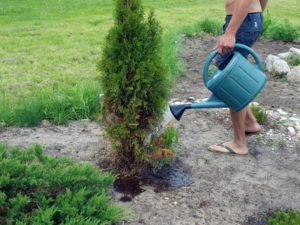
Top dressing
For better wintering, it will not be superfluous to apply autumn fertilizer under the thuja, although if in the spring you have already given a complex fertilizer of prolonged action, then you do not need to additionally feed.
Worth knowing! Autumn fertilizer is a fertilizer that contains a high content of phosphorus and potassium. You can purchase both a special fertilizer for conifers and a regular one marked "autumn".
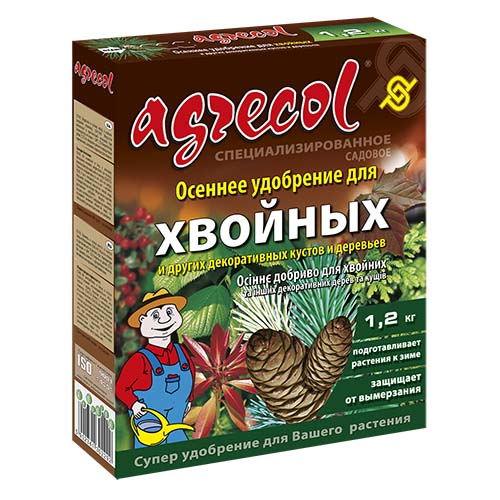
Pruning thuja in autumn
As such, autumn pruning for the winter is not required. Another thing is that you should definitely clean the tree from yellowed old needles and spend preventive pruning (cleaning), i.e. remove diseased or dry, dead branches with pruning shears, cutting them to the very base.
If you form thuja (for example, a ball), then in this case you need to regularly correct her shape and cut her hair (cut out the branches that went "somewhere wrong").
Note! The main rule for pruning thuja is to cut it a little, but regularly (no more than 1/3 of the branch at a time). The bottom line is if you miss a moment and a branch grows very much, then you will have to cut a lot and it will be easy to make a mistake, which will result in a hole in the crown that will overgrow for a long time.
Important! Desirable do not trim the hair in the first year of planting: let it calmly settle down in a new place, and already next year start forming the crown.
Naturally, if you do not cut off the thuja at all, then it can overgrow, because of which it will be poorly blown and illuminated inside due to excessive thickening, which will certainly lead to sad consequences in the form of fungal diseases. Therefore, periodically you also need to perform thinning pruning, removing thickening branches.
Interesting! Tuya Smaragd independently acquires an almost perfect shape and does not need any haircut. But Tue Brabant, for example, requires a regular haircut, without which her crown becomes loose and empty, in other words, the ephedra looks unsightly.
Concerning terms of pruning thujathen the best time is it's late spring - early summerwhen the buds have just blossomed and young shoots have appeared, or late summer - early autumnwhen the tree is already preparing for winter.
Advice! Pruning should only be done in dry weather. If you do this in the rain, then all kinds of diseases can get into open wounds.
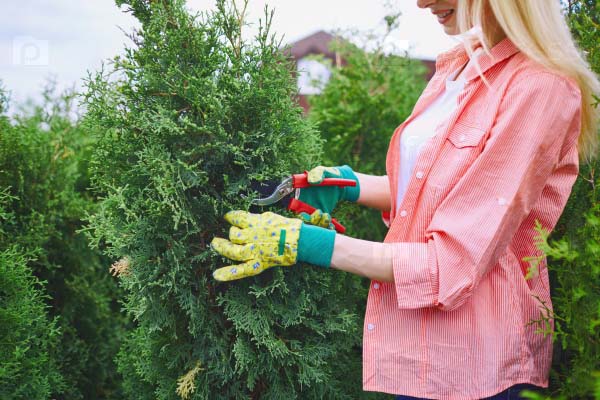
Treatment against diseases and pests
In the autumn, when preparing thuja for winter, it will be good to do preventive treatment of the ephedra from diseases and pests before sending it for the winter.
Advice! It is advisable to carry out even 2 treatments: the first - from diseases and, accordingly, the second - from pests.
- From fungal diseases (in particular from rust) - copper sulfate, bordeaux liquid (30 g per 10 liters - for treatment, 10 g per 10 liters - for prophylaxis) or with special preparations - Hom, Abiga-peak (based on copper oxychloride), Acrobat MC.
- From pests (especially aphids) - Actellik, ordinary Fufanon or Fufanon-Nova, Rogor, Karbofos, Konfidor, Decis (all should be used according to the instructions).
What to do if thuja turns yellow in autumn
Thuja needles can turn yellow in autumn for a natural reason - due to the loss of chlorophyll, a substance that provides food for the needles. They turn yellow, dry out and die, and then new green needles appear in the same place. it normal natural life cyclethat happens to thuja every 3-6 years.
Also, at the end of autumn, thuja needles may turn yellow due to natural defensive reaction of ephedra to cold snap... Then she herself will turn green again.
Moreover, this (yellowing due to stress) will surely happen if the thuja does not have time to adapt to a new place when planting in early fall or late summer.
In any case, whatever reason caused the yellowing and drying of the thuja needles, all affected (yellowed) parts must be cut out mercilessly... Moreover, it is quite simple remove only dried "leaves" (needles), because the greenery will grow on the branches. Do not leave yellow needles if you want to preserve the tree, otherwise they can become an ideal breeding ground for pathogenic fungi and pests!
By the way! The site has a separate article about the reasons and methods of combating the yellowing of thuja needles in spring, summer and autumn.
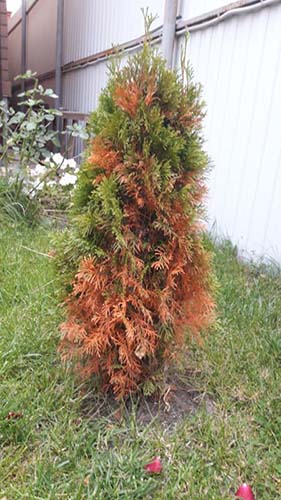
How to keep thuja in winter: rules for preparing for winter and protecting thuja from snow and early spring sun
Do I need to cover thuja for the winter
By nature, thuja is endowed with high frost resistance, therefore, it does not need a classic shelter for the winter, with the exception of only recently planted seedlings.
So, an annual thuja, for example, propagated cuttings, still has a very shallow root system. And if there is a frosty and snowless winter, the plant may die.
By the way! About, how to propagate thuja by cuttings at home, read here.
However, a certain winter protective shelter for thuyas is still required, but for other reasons:
- from snow adhesion (especially important for young plants);
Young thuja (from 1 year to 4-5 years old) gentle enoughbecause of what they can easily deform under snow cover... In other words, when the snow sticks to the branches, they bend strongly and can simply break under the weight of the snow masses.
Important! If you have winters very snowy, then adult thuja is good at least to tie for the winter, even more so if the plant several trunks.
- for prevent sunburn (relevant for young and adult conifers growing in the sun).
By the way! The site already has a detailed article about when and how to cover thuja for the winter.
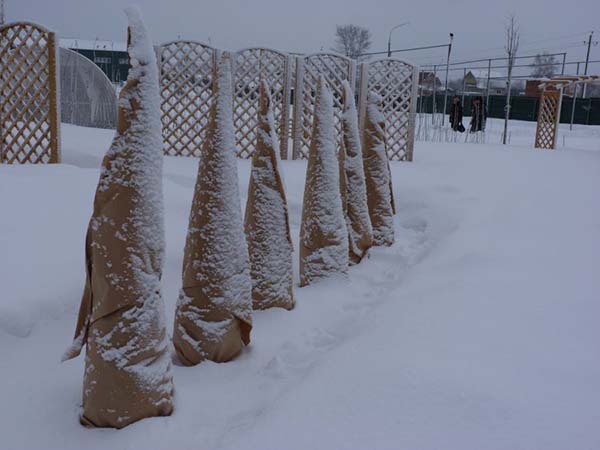
How to properly cover thuja for the winter
As we already found out, first of all you need to take care of protecting the evergreen crown of the thuja, which can suffer from a lot of snow and bright sun in late winter and early spring.
However, before directly covering and protecting the thuja from snow and ultraviolet rays, it is very important to mulch the soil around the trunk circle. Mulch will help to retain moisture (reduce its evaporation) and protect the root system of still young conifers, in which it is not yet too well developed and can freeze out if the winter is very frosty and snowless.
Advice! You can use almost any loose material as mulch: peat, coniferous litter, coniferous bark, compost, humus, sawdust, dry leaves.
The recommended thickness of the mulch layer is 5-10 cm.
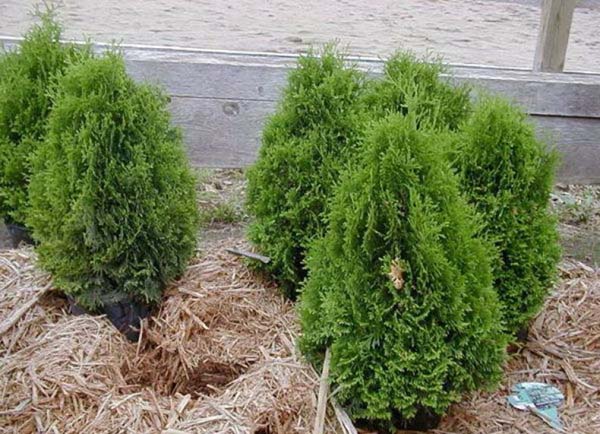
Basic rules for sheltering thuja for the winter:
- In no case do not use cellophane or plastic wrap, since it does not allow air to pass through and the plant under it can rot.
- To protect against snow adhesion great fit nonwoven covering materials, which is good let air through.
However! Many special nonwoven covering materials, breathablee.g. agrofibre, spunbond,let ultraviolet rays pass along with it! They can hide from the snow, but they cannot protect from the sun, so the thuja under them will definitely get burns.
- To protect thuja from the sun can be used gauze, kraft paper, white cotton fabric (sheet, duvet cover), polypropylene bags, burlap, polymer mesh.
Note! All ways to hide thuja for the winter detailed in this separate article.
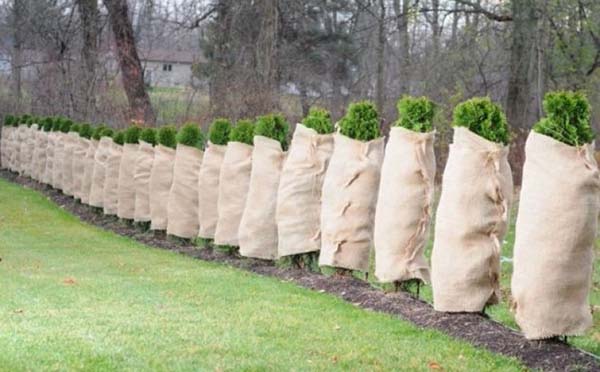
How to keep thuja in a pot in winter
Conifers up to two years old are often grown in pots or containers. So, in order to keep the thuja in a pot until spring, it should be move to a bright and cool room, where the temperature ranges from +4 to +10 degrees (but not below zero), or cool dark basement (not higher than +4 degrees)... And beforehand, the pot must be insulated with something so that the roots do not freeze. Alternatively, you can overlay the pot with mineral wool or wrap it in an old path, and close the tree itself with lutrasil (or spunbond) on especially frosty days.
Important! Don't be afraid to freeze your thuja. At home, the likelihood that it will not last until spring is very low: too dry and hot. But on a balcony (in an apartment) or in an unheated closet or basement (in a private house) - quite.
Advice! If you don't have a better place than a windowsill, then it's better dig pots right into the ground in the fall (for example, in a greenhouse or just in a garden), wrapped with lutrasil (spunbond) on top. Then, in the spring, dig it out, put it in the shade for 2-3 weeks for adaptation and plant in a permanent place in open ground.
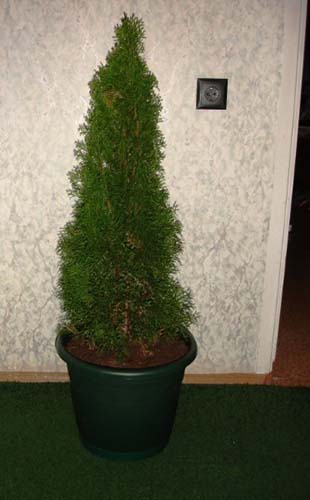
Thus, the autumn care of thuja will not cause difficulties even for the owner of this evergreen plant, who is the farthest from gardening. So that after wintering the coniferous tree does not lose its decorative effect, it must be watered abundantly, fed as needed, treated from diseases and pests, cleaned and cut off from yellowed and damaged branches. And also do not forget to mulch the soil in the near-trunk circle and properly cover it for the winter = protect it from snow and sun.
Video: how to prepare thuja for winter

